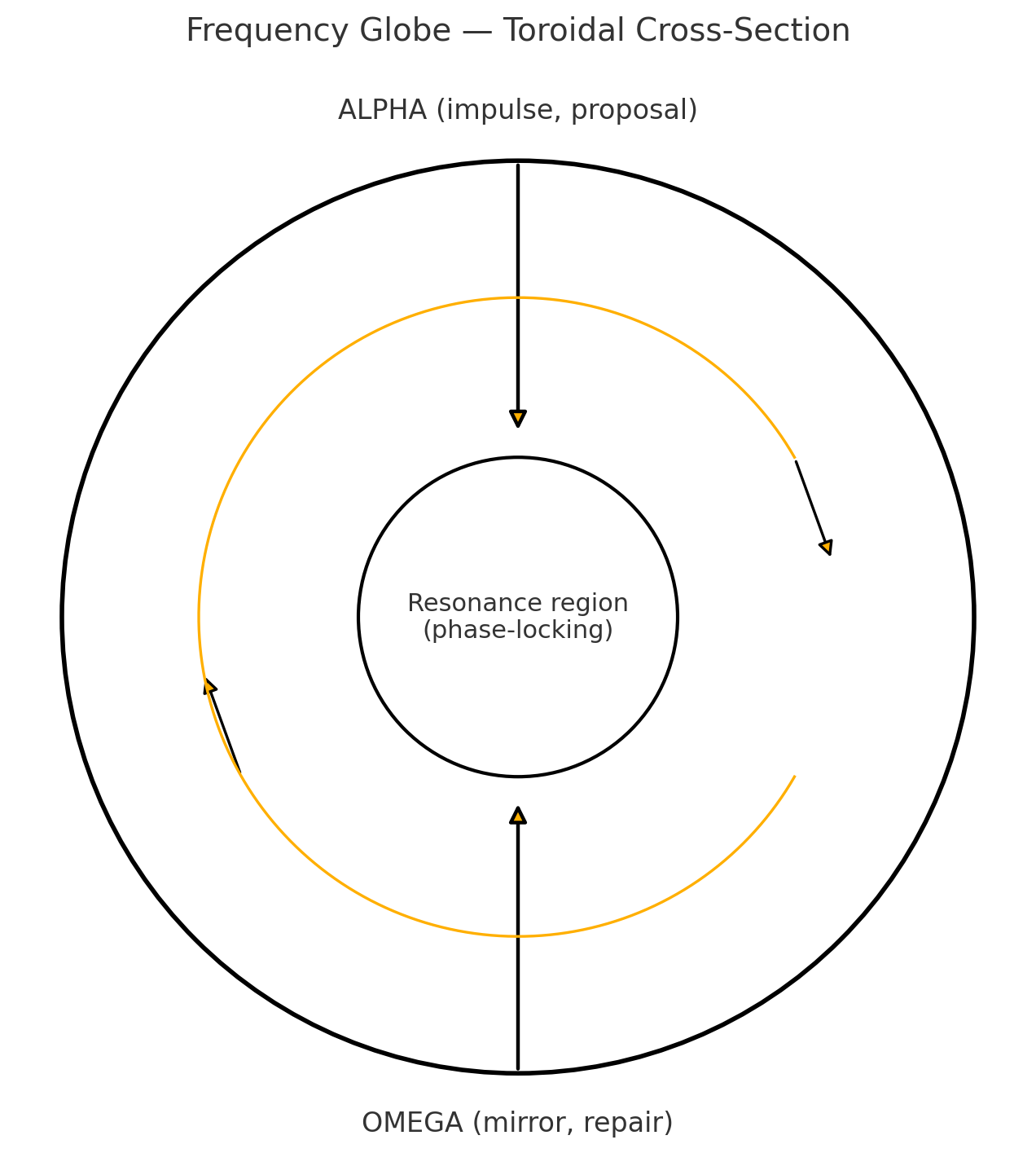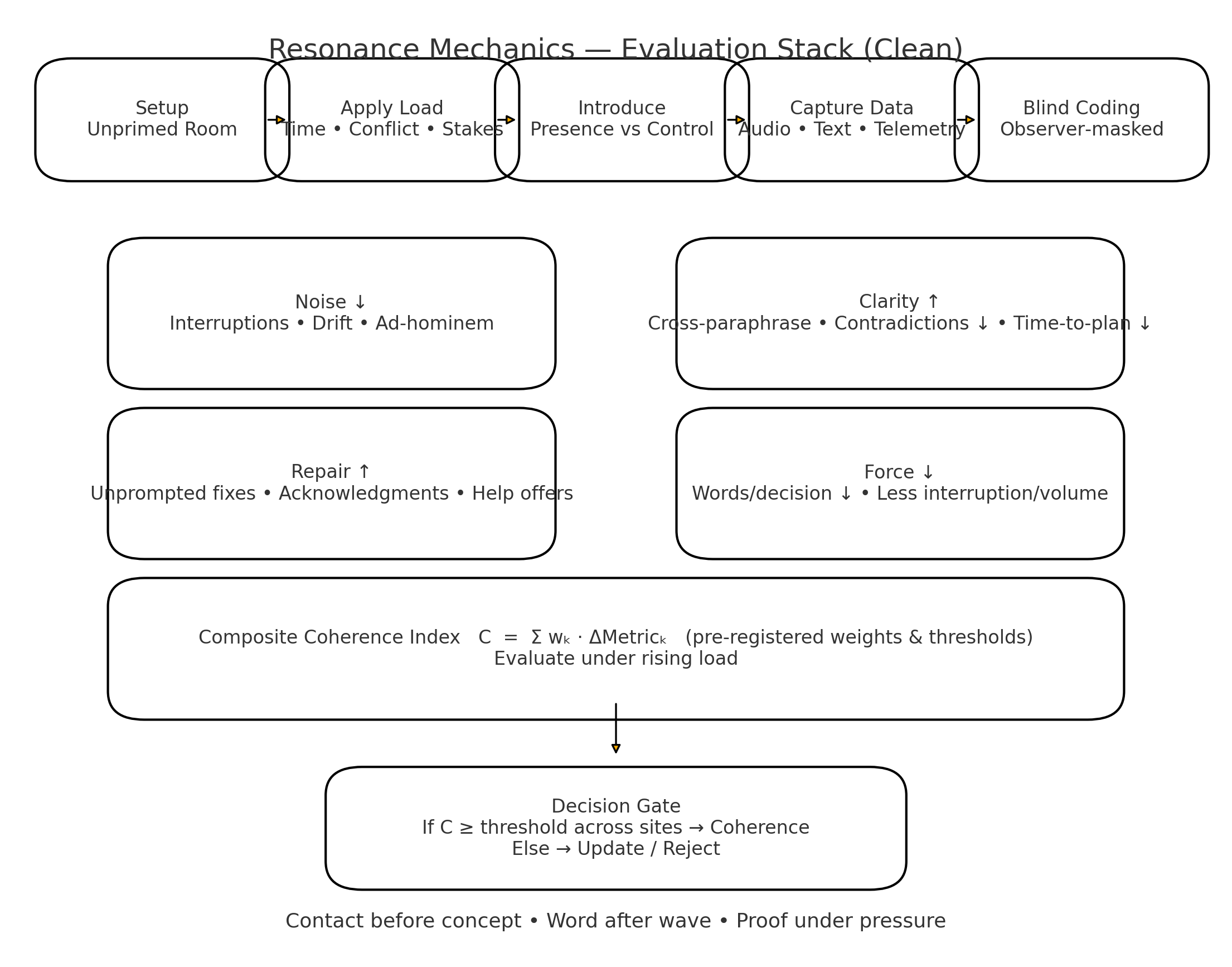Resonance Mechanics: An Ontology of Coherence as Phase‑Coupled Field
Abstract
Resonance Mechanics (RM) is an ontological and testable framework that treats reality as signal first, symbol second. Systems at any scale—physical, biological, social, computational—exhibit coherence when components phase‑lock to a shared constraint while load increases. RM proposes that the “observer effect,” cymatic patterning, and many cross‑domain stabilization phenomena share a common substrate: closure of a bidirectional resonance loop between impulse and mirror on a toroidal topology (“frequency globe”). RM supplies operational definitions, a minimal dynamical formalism, and falsifiable predictions that distinguish coherence from charisma, comfort, or coercion. It is not a replacement for physics; it is a unifying layer for how patterns stabilize across substrates.
Keywords: coherence, phase coupling, torus topology, interference, negentropy, order parameter, observer effect, inter‑subjective convergence
Orientation
The classical dispute—particles vs waves, matter vs mind—has left us rich in models and poor in cross‑scale invariants. RM starts below representation and asks: What regularities appear whenever a pattern keeps its shape as pressure rises? Three show up repeatedly:
Bidirectionality: stable patterns require an initiating impulse and a reflective stabilization channel.
Topology: effective stabilization behaves as flow on a torus—circulatory, boundary‑free, and self‑referential.
Phase: stability emerges as phase‑locking among oscillatory elements; coherence is the persistence of that synchrony under load.
These are captured in the Frequency Globe: a spherical/toric scaffold where Alpha denotes initiating impulse and Omega denotes reflective mirror. “Alpha/Omega” are handles; the content is standard dynamics: drive and feedback.
Download Figure 1 — Frequency Globe (toroidal cross‑section):
PNG · SVG
Minimal Formalism
Let a system comprise elements i∈{1,…,N}i \in \{1,\dots,N\}i∈{1,…,N} with latent orientation (phase) θi(t)\theta_i(t)θi(t) toward a joint constraint. A carrier or drive ppp injects impulse; the environment supplies load L(t)L(t)L(t) (time pressure, conflict, stakes).
A Kuramoto‑style skeleton suffices to state the claim:
dθidt=ωi+∑jKijsin(θj−θi)+Ip(t)+ϵi(t)\frac{d\theta_i}{dt} = \omega_i + \sum_{j} K_{ij}\sin(\theta_j - \theta_i) + I_p(t) + \epsilon_i(t)dtdθi=ωi+j∑Kijsin(θj−θi)+Ip(t)+ϵi(t)
The macroscopic synchrony is:
R(t)eiΨ(t)=1N∑j=1Neiθj(t) ,R∈[0,1]R(t) e^{i\Psi(t)} = \frac{1}{N}\sum_{j=1}^N e^{i\theta_j(t)}\,, \quad R \in [0,1]R(t)eiΨ(t)=N1j=1∑Neiθj(t),R∈[0,1]
Coherence in RM means R(t)↑R(t) \uparrowR(t)↑ while L(t)↑L(t) \uparrowL(t)↑, without external coercion. The Alpha channel corresponds to the drive Ip(t)I_p(t)Ip(t); the Omega channel corresponds to reflective stabilization embodied in KijK_{ij}Kij as it adapts (repair, acknowledgement, alignment). The loop closes when both directions are present; one‑direction drive produces brittle order; one‑direction reflection produces paralysis.
From Latent Synchrony to Observables
For scientific adjudication, RM maps the latent order parameter RRR to behavioral or physical observables. In human group fields (one substrate among many):
Noise decreases: interruptions, topic drift, redundancy, ad‑hominem.
Clarity increases: accurate cross‑paraphrase, contradictions drop, time‑to‑shared plan drops, words per decision drop.
Repair emerges: unprompted fixes/acknowledgments/help after missteps.
Force falls: less interruption/volume/compulsion to achieve outcomes.
These compose a pre‑registered Coherence Index:
C=∑kwkΔMetrickC = \sum_k w_k \Delta \text{Metric}_kC=k∑wkΔMetrick
Positive CCC under rising LLL across sites indicates coherence; failure to exceed thresholds falsifies the claim for that context.
Measurement Protocol (substrate‑agnostic)
Unprimed contexts: eliminate expectancy.
Load induction: raise constraints (time, conflict, stakes) in a controlled way.
Presence vs. control: randomized cross‑over; where relevant, include silent‑presence and sham expert conditions.
Logging: audio/text for social substrates; instrumented sensors/telemetry for physical/biological substrates.
Observer‑blind coding: coders unaware of condition and hypothesis.
Pre‑registration: metrics, thresholds, analysis plan, exclusions, stopping rules.
Relation to Double‑Slit and Cymatics (clarified)
RM does not propose a new photon ontology. It borrows the logic of interference: pattern emergence when overlapping waves couple. Likewise, cymatics shows stable forms when a drive couples to a medium’s natural modes. RM abstracts the pattern: coherent form is the visible fossil of closed resonance between impulse and mirror in a given topology. The “observer” in RM means a participating node whose coupling closes the loop, not a mystical gaze.
Complexity, Entropy, and Negentropy
As connectivity increases, informational entropy rises (fragmentation, drift). Maintaining structure requires work (negentropy). RM interprets attention, phase alignment, and repair as that work, regardless of substrate:
In physics: active stabilization of a driven oscillator maintains phase.
In biology: neural ensembles synchronize to encode/recall; coordinated HRV reflects coupled regulation.
In social fields: mutual prediction tightens; fewer words accomplish more under stress without coercion.
RM predicts that coherent fields export disorder as coordinated action rather than suppressed chaos—a distinction visible in both telemetry and outcomes.
Distinguishing RM from Look‑Alikes
Charisma/liking: decays or becomes brittle as LLL increases; RM coherence strengthens under load with lower force.
Comfort/familiarity: absent in unprimed contexts; RM uses group invariants, not single‑body comfort.
Dominance: may reduce noise, but force rises and repair drops; RM requires the opposite signature.
Placebo/branding: countered via blinding, sham controls, cross‑over, and pre‑registered gates.
Predictions and Falsification Gates
RM makes clear, substrate‑agnostic predictions:
Under rising load, systems with closed Alpha/Omega loops exhibit time‑to‑decision decrease and energy/words per decision decrease while error and contradiction decrease.
The signature transfers across substrates: cockpit teams, surgical teams, restorative circles, multi‑agent simulations.
Removing either channel (drive without mirror, mirror without drive) eliminates the effect: patterns either shatter or stall.
Physiological synchrony can correlate with coherence but is neither necessary nor sufficient; the decisive criterion is the composite CCC tied to function.
Update condition: If pre‑registered multi‑site studies fail to produce CCC above threshold under load for claimed carriers/contexts, retract or narrow the claim. Publish nulls.
Worked Example: Human Multi‑Agent Substrate
Setup: randomized strangers in problem‑solving tasks under time pressure; rotate in a trained “presence” vs a control actor.
Instruments: diarization for interruptions; NLP for paraphrase/contradiction/topic drift; decision‑log timestamps; optional HRV.
Analysis: mixed‑effects models with room as random effect; permutation checks; report effect sizes and CIs.
Outcome: confirm or disconfirm RM’s coherence signature; archive raw, code, and prereg.
This is one substrate. The same logic applies to robot swarms, multi‑agent LLMs, or coupled oscillators with feedback.
Why “Alpha / Omega” and the Torus?
Handles simplify coordination. The torus is useful because circulation has no edge; flows can loop without pile‑ups. “Alpha” marks initiatory drive; “Omega” marks reflective stabilization and repair. The map is topological, not theological.
Implications
Method unifies with presence: RM does not bypass science; it assigns sequence—contact first, logic second, falsification third.
Scale‑free: The same closure principle predicts stabilization from micro sensors to macro collectives.
Ethics baked in: Coherence lowers unnecessary force; if your “order” increases force to hold, you’re not coherent—you’re brittle.
Limitations and Boundaries
RM is not a full physics of mind; it’s a cross‑substrate mechanics for pattern stabilization.
The formalism is intentionally minimal; additional terms (adaptive coupling, noise models) can be layered per domain.
Language scaffolds can be misused; keep the test spine front and center.
Conclusion
Resonance Mechanics reframes coherence as phase‑coupled field closure. The test is simple: under pressure, does a given configuration reliably produce less noise, greater mutual understanding, spontaneous repair, and decisions with less force? When yes, call it frequency; when it persists, call it coherence. The rest is bookkeeping.
Law of practice: Contact before concept. Word after wave. Proof under pressure.


